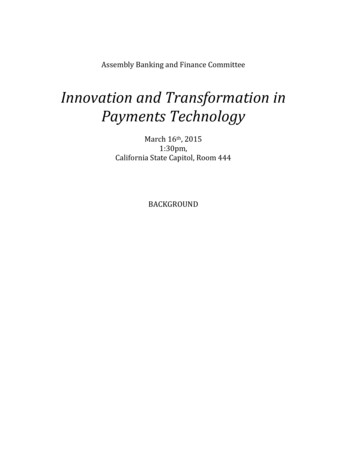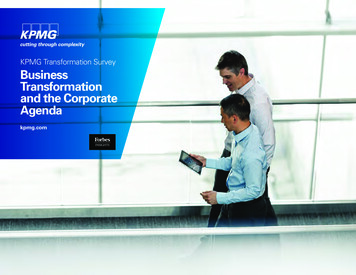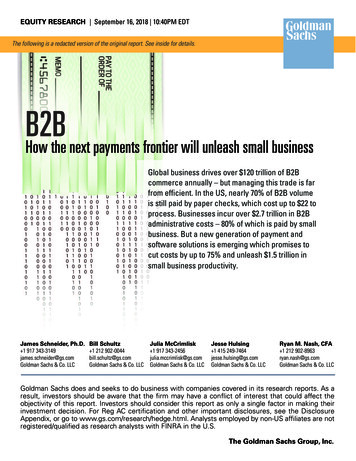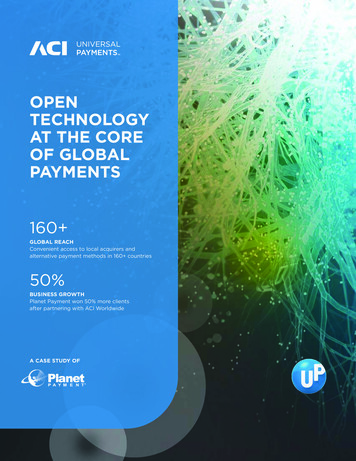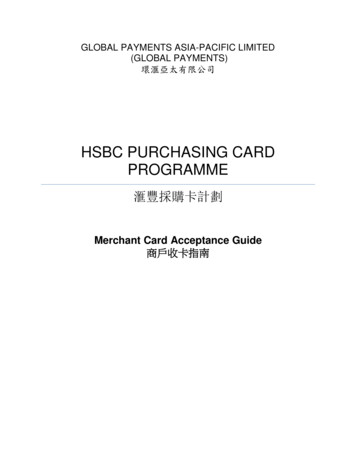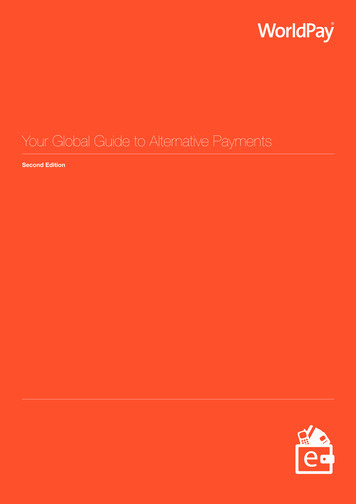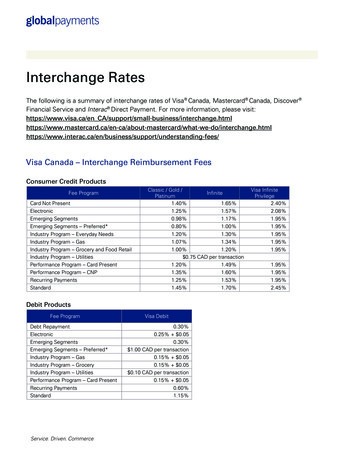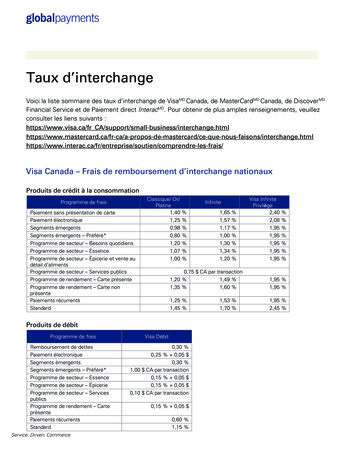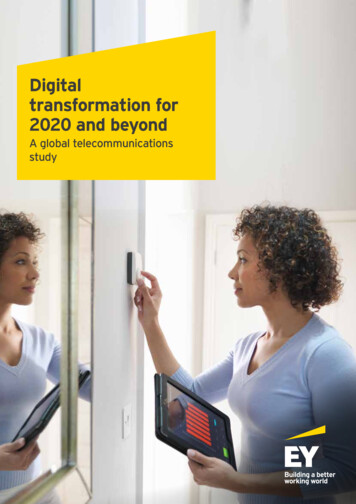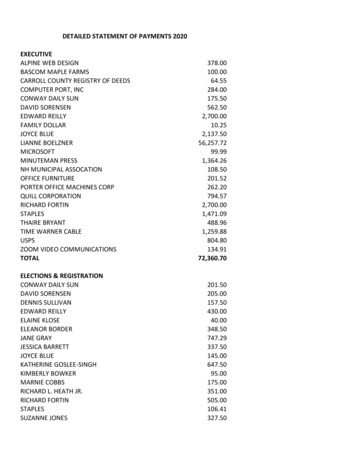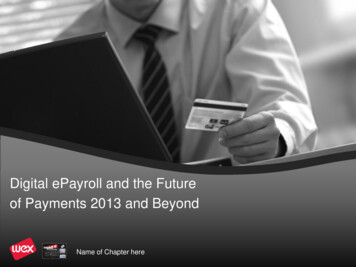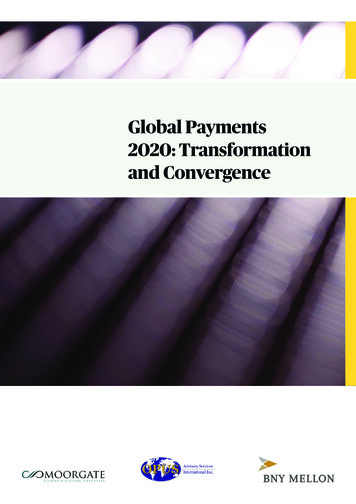
Transcription
Global Payments2020: Transformationand Convergence
GLOBAL PAYMENTS 2020 : TRANSFORMATION AND CONVERGENCE // 2Global Payments2020: Transformationand ConvergenceForewordFOREWORD2EXECUTIVE SUMMARY3PAYMENTS TODAY5Redefining Payments:A Strategic View5State of the Market5THE GLOBAL VIEW7Regional Highlights7Market Focus9THE WORLD OF PAYMENTS:LOOKING TO 202021The Future of Payments:A Notional End-State21Payments in 202022Market Transformation26Convergence29THE BRIDGE FROMHERE TO 202033Bridging Developments33CONCLUSION42RECOMMENDATIONS45Please click on the linksunder graphics to accessmore informationBy Dominic Broom, Head of Sales and RelationshipManagement for Europe, the Middle East and Africa,Treasury Services, BNY MellonThe following pages conjure a vision of the payments landscape in 2020 andbeyond. We believe that the world of payments is going to be fundamentallytransformed between now and then. It will be reshaped by technology and redefinedby regulation, the emergence of new economic powers, and changes in theglobal currency landscape. Most importantly, payments will be refocused from acommoditised proposition to a strategic, value-adding solution; one that is offeredwith greater focus on the broader commercial and transactional context withinwhich a payment (or a transfer of value) takes place.Indeed, in 2020 a payment will be understood to be much more than just thesettlement of a transaction or the mere movement of funds. The broadercommercial, retail, investment or public sector environment of payments willbe taken into account, and “payment-proximate” activities (such as investmentdecisions, trade-related financing and risk mitigation, the cross-border movementof salaries and pensions and a host of other core activities) will become part of thebasis upon which providers develop greater value propositions.The world of payments in 2020 will look very unlike it does today, and markettransformation has already begun. The competitive landscape will be redefinedby the entry of non-traditional providers, the evolution of new solutions providedby financial institutions, and the development of strategic alliances that crosstraditional sectoral boundaries. Besides transformation, there will also be majorconvergence: convergence around products and solutions linked to payments;around technology platforms and clearing capabilities that will be increasinglyglobal in nature and reach; around the operation of global securities and currencymarkets; and with regard to regulatory regimes that today are often fragmentedand unaligned.Looking further forward, it is clear that any “end-state” post-2020 will be largelyunrecognisable. That said, we envision it might have integrated global settlementand clearing systems, and platform-agnostic channels that allow for maximumclient access, flexibility and convenience. Indeed, as a young, ‘tech-savvy’ generationof business leaders emerges, the expectations of retail/consumer and commercial/corporate end-clients with regard to payments are likely to be far more closelyaligned than they are today.In all of this, commercial banks can remain key players, but only if they respondquickly enough and with compelling value propositions.In the following pages, we shall take stock of the state of play today, paint a pictureof the future of payments, identify key developments already underway and examinewhat is needed from market participants aspiring to bridge the gap between todayand 2020.
GLOBAL PAYMENTS 2020 : TRANSFORMATION AND CONVERGENCE // 3Executive SummaryThe global payments landscape is in a state of fundamentaltransformation, comparable in significance to the advent ofdownloadable entertainment for the video rental business.Banks in particular will need to move swiftly if they are totake advantage of the opportunities on offer in the globalpayments business, or risk losing out to nimbler competitors.The world of global payments in 2020 will look very unlike it does today; indeedits “end-state” post-2020 will be largely unrecognisable. Key factors influencingthese changes will be the impact of technology, changing customer expectations (inparticular those of retail customers), changing global demographics, shifts in globaltrade flows and currency markets, and the growing impact of regulation.The market is already being reshaped by both traditional and new types of paymentproviders. Conspicuous amongst these are new non-bank competitors, some ofwhom are already well established. For example, PayPal is servicing a fast-growingnumber of customers across the globe for payments, and is now also entering thelending market.The payments market in the developing world – where traditional paymentinfrastructure is lacking – is more fragmented still, and shows examples oftechnological “leapfrogging”. Indeed, the fast take-up of new technology is enablingpayment services to be provided to the unbanked, as demonstrated by the successof M-Pesa in Kenya, and its recent entry into the European markets.Large technology and social media companies such as Amazon, Google andFacebook are seeking entry into the payments market. At the same time, newelectronic currencies such as Bitcoin offer payment options independent ofgovernment control.In an industry traditionally served by banks, these new and innovative nonbank payment providers are entering the market and rapidly gaining ground.This development could easily accelerate to a tipping point if banks do not actsufficiently swiftly and decisively, positioning themselves to offer attractive, valueadded propositions to both individual and corporate customers.In fact, a significant threat is posed by large technology and social mediacompanies. If such firms can leverage, even monetise, their considerablecustomer reach by presenting attractive, straightforward and secure paymentpropositions alongside their other non-payment offerings, they could succeed indisintermediating banks, particularly in growing segments of the global paymentsbusiness. This is of particular relevance as a young, ‘tech-savvy’ generation starts
GLOBAL PAYMENTS 2020 : TRANSFORMATION AND CONVERGENCE // 4to take on leadership roles in global commerce. This new generation of leaders, allvery familiar with the world of social media and e-commerce, will expect to run theirbusinesses using 21st century tools.In addition to threats from social media and technology-based companies, banksalso face growing competition from clearing and network solution providers, whosebusiness models are reshaping global markets, changing the way multi-currencycapabilities are delivered, and impacting the value proposition of traditionalcorrespondent banking models.Regulation and compliance – however necessary and well-intentioned – can beperceived as a concern, as the time and cost burden of meeting these requirementsforces a deployment of resources away from the development of new client-facingproducts and solutions. Furthermore, internal bank dynamics, including the desireto retain familiar delivery options and relationship approaches, can be a seriousthreat to the ability of individual banks – and the industry – to respond effectively totransformational changes in the market.Some banks are already responding to these challenges. From the search forinnovative strategic alliances and adaptation to the evolving expectations ofimporters and exporters, to the development of new propositions aimed at creatingvalue around global remittance solutions, and translating regulatory requirementsinto a competitive advantage: all are examples of the ways in which banks at theforefront are responding to the new world of global payments.For others, it is time for a wake-up call. Banks haven’t always been the quickestoff the mark when it comes to adaptation – be it responding to changing customerexpectations or adopting new technologies. But they must be perceptive andproactive if their payments businesses are to survive in the face of thesefundamental market transformations.What this entails will differ according to regions, markets and client segments, butone thing is clear: going forward, it will no longer be sufficient to regard paymentsas utility products; commoditised, undifferentiated and volume-driven. Instead,successful payments providers, whether traditional or emerging, will be those:–– taking a strategic view of payments and “payment-proximate” activities, to deviseand offer value-added solutions and products,–– identifying markets and lines of business where payments are a prominentaspect,–– updating their technology to deliver services and solutions in line with customerexpectations, as opposed to internal operational silos,–– actively targeting payment flows related to demographics, such as thecompensation and pension flows linked to the baby boomer generation, or theemerging middle classes in China and Indonesia,–– targeting high-growth and traditionally poorly served customer segments such assmall and medium sized enterprises (SMEs),–– exploring non-traditional alliances and partnership models, including strategiccross-sectoral partnerships with those they might not have considered previously(such as mobile or social network operators), to enable access to new client bases.The successful payments providers of 2020 and beyond will be those taking actiontoday. Those that do not, risk being left behind.
GLOBAL PAYMENTS 2020 : TRANSFORMATION AND CONVERGENCE // 5Payments TodayREDEFINING PAYMENTS: A STRATEGIC VIEWPAYMENTS ADD VALUE BY TAKING ACCOUNT OF “PAYMENT-PROXIMATE”ACTIVITIESPayments have historically been viewed as utility products; fundamentallytransactional and tactical in nature, undifferentiated and volume-driven. In fact, apayment was often perceived as merely the final step in a transaction, with limitedopportunity to provide value-added services or solutions.However, payments – as transfers of value – can be decidedly more strategicwhen viewed in context of the broad scope of “payment-proximate” activities. Suchactivities provide a significant opportunity to add demonstrable and differentiatedvalue; be it in trade, investment, retail flows, the movement of salaries and pensionsacross borders, the settlement of government contract activity or a host of othersuch undertakings, some involving a high mass of low-value payments, othersnecessitating smaller volumes of higher-value payments.Trade flows perfectly illustrate the importance of “payment-proximate” activitiesand their link to value-added payment solutions. In trade finance, a provider canoffer significant support in terms of financing and risk mitigation on either sideof any payment. The acceptance of an invoice by an importer, which creates an“approved payable”, can underpin financing options and may give rise to the needfor complementary risk mitigation support. Certainly, significant opportunity existsaround the transfer of value from one party to another. This is true in any area ofactivity where such a transfer – a payment – can be effected.In addition, the opportunity to link data and analytics to the flow of payments isfrequently cited as a probable and attractive evolution of payment propositions,both for the benefit of parties involved in the transaction, and as a means of meeting“Know Your Customer” (KYC) requirements linked to various regulatory regimes. Thatsaid, some industry specialists caution against linking to sensitive data that couldinadvertently become known to third-party providers.Ultimately, a payment in 2020 will be about transferring value and providingstrategically-important solutions in support of broader activity in areas includingtrade, investment, retail, commercial and public sectors.STATE OF THE MARKETWhether measured by value or volume, the global payments business is vast and willcontinue to expand between now and 2020. However, a number of factors and trends– some already having an impact – will play a critical role in shaping the nature ofthis expansion.Geopolitically, the world is becoming increasingly multipolar, and as economicpower shifts so too does the respective importance of certain currencies. Therapid ascendance of China’s Renminbi, now the second most-used currency fortrade finance, is a case in point. Currency markets have also been reshaped by theadoption of the Euro.Advances in technology have already changed the way we conduct payments, andwill continue to heavily influence the market. PayPal, the provider of online paymentsolutions, illustrates the growth potential of such electronic/platform-basedpayments, having generated US 1.95 billion in revenue in Q2 of 20141.
GLOBAL PAYMENTS 2020 : TRANSFORMATION AND CONVERGENCE // 6Elsewhere in the technology space, internationally-known brands such as Amazon,Google and Apple are looking to monetise their enormous client reach to expand inthe payments space, as reported in Forbes magazine in December 20132.Global demographics are influencing the payments landscape throughredistribution of financial resources across borders (see below figure 1). Highgrowth markets in Asia, Africa and elsewhere are developing their own paymentpropositions for areas as varied as online commerce and local agricultural trade.Global foreign direct investment (FDI) inflows increased by 9% to US 1.45 trillion in2013, according to UNCTAD’s 2014 World Investment Report3. Developed countriescurrently account for 39% of these flows (a share worth US 566 billion), whileinvestment flows to developing economies grew to a new high of US 778 billion (a54% share).International remittances present another burgeoning source of global paymentflows. According to the World Bank‘s Migration and Development Brief4, globalremittances (including those to high-income countries) are estimated to reachUS 581 billion this year, and grow to a record US 681 billion by 2016. Remittancesto developing countries are projected to continue growing strongly over the mediumterm, averaging an annual growth rate of 8.4% to reach US 516 billion in 2016.Finally, trade flows are being reshaped by the increasing engagement of developingmarkets, with intra-regional trade flows becoming increasingly significant,according to a recent McKinsey & Company/SWIFT report for Sibos5. Furthermore,there has been a shift away from established documentary trade payment andfinancing mechanisms, towards less complex and less expensive open accountterms, as well as new payment and financing solutions (such as the Bank PaymentObligation) aimed at supporting global supply chains.Fig. 1: Putting Growth Back on the Banking Agenda, McKinsey & Company and SWIFT, 2013
GLOBAL PAYMENTS 2020 : TRANSFORMATION AND CONVERGENCE // 7The Global ViewREGIONAL HIGHLIGHTSAlternative payments such as e-wallets, mobile and digital currencies, are playingan increasingly prominent role in the payments space – a trend largely driven bythe emerging markets, but one that is becoming evident across the globe. Indeed,though card transactions remain by far the most popular payment method in theUnited States, there are many countries that have not only adopted alternativepayment methods but have come to view them as their trusted and preferredpayment method of choice. In Africa, for example (see market focus on page 14),mobile payment users outnumber bank account holders (M-Pesa is Kenya’s mostpopular payment method); in Germany, Capita6 reports that alternative paymentsaccount for 66% of e-commerce purchases; and in China, alternative paymentmethod Alipay dominates the market, and has, in fact, overtaken PayPal to becomethe largest global mobile payments platform, with over 300 million registered users.Fig. 2, below, depicts the evolution of the global payments market and the growthof alternative payment mechanisms. According to Worldpay, alternative paymentscould account for 59% of settlement activity by 2017, up from 43% in 2012.GLOBALE-TRANSACTIONPAYMENTMIXAlternative payments20121%2%Bank transfer1%59%Direct debit7%18%CardsCash ondelivery8%11%OtherBank transfer5%17%5%Cash ondelivery71%US & Canada2%59%By 2017, alternative payment methods will account for59% of all transactions, an increase from 43% in f global onlinetransactions weremade using e-wallets in2012, replacing that ofdebit and credit cards.Direct debit4%37%By 2017 cashon deliverywill accountfor 2% ofe-transactionsAlipay and PayPal continue todominate globally as the mostprevalent e-wallet types.Direct debitCards23%8%Cash sia/PacificUS & CanadaOther14%Paper-basedinvoicesare beingdisplacedBank transferAfrica &Middle East18%by digital, guaranteed forms ofinvoice such as Klarna, BillPayand RatePay.11%Cash ondelivery47%Bank transfer29% of e-transactions madeusing non-card methodsEurope41% of e-transactions madeusing non-card methodsOther1%Cards48%0%Direct debit3%Direct debitBank transfer34%5%Latin America53% of e-transactions made usingnon-card methodsCash ondelivery10%OtherCardsAsia/Pacific63% of e-transactions madeusing non-card methodsE-walletsAfrica & Middle EastCardsOtherE-walletsCash ondeliveryBank transferDirect debit*All figures are from 2012.Fig. 2: Worldpay, Your Global Guide to Alternative Payments, 201366% of e-transactions madeusing non-card methods
GLOBAL PAYMENTS 2020 : TRANSFORMATION AND CONVERGENCE // 8Notably, the US and Europe exhibit relatively modest uptake of new paymenttechnologies, possibly in part because development is hampered by the existenceof legacy technologies, and partly because the relative efficacy of current solutionsdoes not motivate urgent adoption of new models . However, by 2020, these marketswill have caught up and achieved greater alignment with their “leapfrogging”counterparts.Once again, the developing markets are leading the way, with countries such asBrazil, India and China – home to an increasingly middle class and more mobilepopulation, where newly-banked yet “tech-savvy” generations are more open to newideas – fuelling demand for innovative, technology-driven and easily-integratedtransaction methods.Fig. 3: McKinsey Global Mobile Payments Consumer Survey Referenced in McKinsey onPayments 2012As demonstrated above in Fig. 3, mobile payments in particular are set to showsignificant growth across all markets – although, as Fig. 4 shows below, there iscontinued market differentiation with regards to the preferences of consumers.
GLOBAL PAYMENTS 2020 : TRANSFORMATION AND CONVERGENCE // 9Fig. 4: McKinsey Global Mobile Payments Consumer Survey Referenced in McKinsey onPayments 2012In combination, these illustrations show that a uniform approach to solution deliveryacross markets is unlikely to succeed, and that a more tailored, market-specificstrategy is likely to better align a provider to their end-client.MARKET FOCUSAMERICASDespite a testing few years, the United States (US) remains a top global politicaland economic power. Even in a world of multipolar influence, the US will remainan economic force well past 2020. Its currency remains the dominant currency ofinternational trade, capital flows and investment, and a tool of politico-economicinfluence.Alongside Europe, the US is a leading consumer market and major exportdestination. It is also a major source of (and destination for) capital and investment,and remains a financial centre and centre for technological innovation – hometo several of the major (and potential) innovators in the payment space, such asPayPal, Apple and Facebook.Increasing globalisation and shifting global demographics is shaping the USpayments market. For example, International Business Times7 reports that whileLatin America remains one of the US’s main trading partners, Latin America isincreasingly turning its attention to China, with two-way trade flows between theregions increasing by 660% between 2000 and 2009 – from US 13 billion to overUS 120 billion.According to IHS8, the US – inarguably the world’
GLOBAL PAYMENTS 2020: TRANSFORMATION AND CONVERGENCE // 6. Elsewhere in the technology space, internationally-known brands such as Amazon, Google and Apple are looking to monetise their enormous client reach to expand in . the payments s
